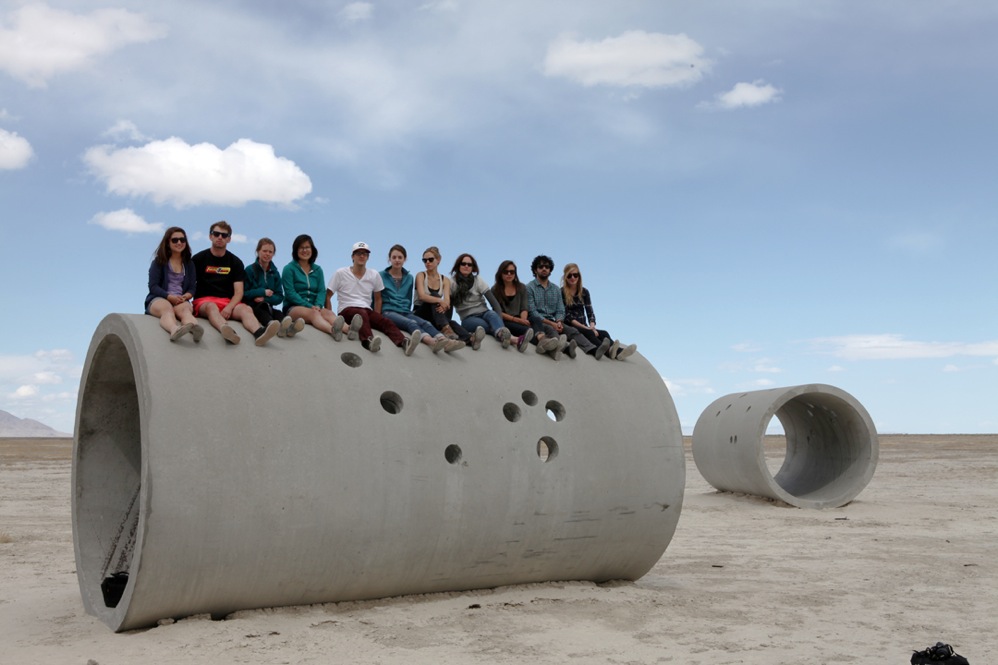Since Thomas Jefferson sent explorers to the West, the landscape has inspired painters, photographers and "earth artists," whose canvas is the land itself.
Students in the University of Virginia summer session course "Earth Art and Photography" spent two weeks drawing inspiration for their own photography from that same landscape, creating works that are about places, and learning to reveal their "emotional and intellectual response to the world," said William Wylie, the course's instructor.
Wylie, a studio art professor in U.Va.'s College of Arts & Sciences, captured the Kansas landscape in one book, "Route 36," and Colorado in his first two books, "Riverwalk" and "Stillwater," in which he responded to a river, the Cache la Poudre. He said he wanted to share the landscape he found compelling.
"My goal is to help students realize they need to look further than their own front yard for subject matter," Wylie said. "That they could go a bit further and discover something new."
For second-year anthropology major Helena Groves, photography is a hobby, but said she is considering declaring it as a minor. She found the trip fueled her creativity. "I had hit a plateau in my photography and this trip offered a whole score of new material and landscapes to shoot," she said.
The trip, a combination of camping, hiking and photography, provided both adventure and an opportunity to visit four earth art works: "Spiral Jetty," a work by sculptor Robert Smithson in the Great Salt Lake near Rozel Point in Utah; "Sun Tunnels," a 1976 work by artist Nancy Holt on the Bonneville Salt Flats near Wendover, Utah; sculptor Walter De Maria's "Lightning Field" in New Mexico; and "Double Negative," by land art pioneer Michael Heizer near Overton, Nevada.
"Those are places that most of them would probably never have gone to on their own," Wylie said.
David Morales, a fourth-year foreign affairs major who takes photography classes when his schedule allows, said he didn't have high expectations for visiting the land art pieces when they studied them in the first two weeks of the course.
"The moment I arrived, however, I was completely astounded," he said. "As many of the earth artists stressed, the surroundings of the artwork are just as much a part of the work as the work itself. This way of thinking really resonated with me and challenged me to think in different ways."
From the moment she got off the plane in Denver, fourth-year anthropology and studio art double-major Courtney Springer began focusing on the light and space. She fell in love with the "dynamic landscape and the quality of the sky."
"There is so much of it and the sky is different out there," she said.
"Spiral Jetty" was particularly inspiring, she said. "We reached the site around dusk and camped out there, and we woke up to this incredible view the next morning – the light was so rich and it worked really well with the intense red of the Great Salt Lake. Most of my favorite images came from that morning."
The jetty, a counterclockwise coil of natural materials jutting from the shore, has different persona depending on the height of the water in the lake. "Smithson chose to put the 'Spiral Jetty' at this location because the water has a pink hue to it due to the brine shrimp that are there and then he made the jetty out of black volcanic rock," Wylie said. Though submerged, it was still visible under the surface the day they visited.
Along the way, they also took photos at natural wonders, including granite boulders at Vedauwoo State Park in Wyoming; the Grand Canyon, both from the top and part-way down; and the Great Basin National Park, home to 4,000-year-old bristlecone pines. They voted unanimously to camp in a snowstorm and woke up to 10 inches of snow at their campsite at Great Basin, which was at 10,000 feet. They then hiked to 12,000 feet to photograph the pines.
At each stop, Wylie challenged the students to not just take documentary photos, but to use the earthworks and landscapes to generate their own interpretation of the land.
Morales appreciated the fieldwork aspect of the course and the opportunity to work closely with Wylie, which he described as a "privilege."
"If I wanted to try something new, or had some concerns with a certain shot, I could ask my professor right there and then for tips or suggestions," he said. "Immediate feedback is so much better than waiting for a class critique weeks later."
They also were invited to work with performance artist Richard Kraft on a stop in Wendover, Nev., researching a project titled "100 Walkers."
"I learned so much," Morales said. "Not only as a photographer, but as an artist and person."
– by Jane Ford
Media Contact
Article Information
June 21, 2012
/content/western-landscape-broadens-summer-photography-students-horizons

